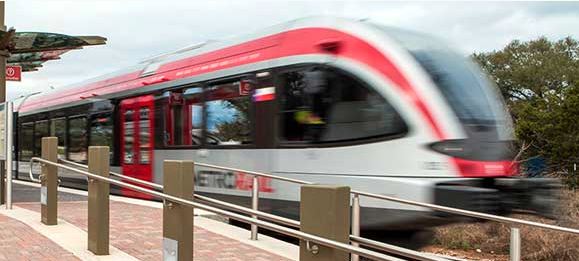City Council and Capital Metro talk Project Connect capacity and ridership projections
Thursday, October 31, 2019 by
Ryan Thornton The Capital Metropolitan Transportation Authority has put together some potential outcomes for a public transit overhaul in the coming decade based on months of technical analysis, but regional and city leaders aren’t sure what to think with so many decisions riding on predictions of, well, ridership.
The transit agency released preliminary cost estimates for the entire Project Connect system this week, providing ranges of potential daily passengers for the high-capacity Orange and Blue lines that could be achieved with different investment choices.
For both lines, light rail could be expected to carry about 10,000 more daily passengers than bus rapid transit if done well, and for the Orange Line, would carry at least as many people as an excellent bus rapid transit line.
During the joint meeting with City Council and Capital Metro Wednesday, Dave Couch, program manager for the project, said light rail will generally do better than buses even if the systems are comparable due to “rail bias,” or the fact that people typically prefer to ride rail.
But light rail vehicles also have more space, enough for 172 people per vehicle compared to 115 on a bus, according to the agency’s data. While you can add capacity to buses with articulated (accordion) or even bi-articulated buses, light rail cars can be connected and disconnected as desired and each added car will have a higher capacity.
But capacity is different from ridership, and the agency is trying to strike the right balance between what the system can carry and what it needs to carry.
The agency’s ridership analysis addressed that question using the Capital Area Metropolitan Transportation Authority’s population estimates model, which indicates the city will grow by 32 percent to 1.3 million residents by 2040, a number that does not account for many significant developments such as the South Central Waterfront and Rainey Street. Because the numbers are based on population, the ridership estimates also don’t consider the impact of the future expansion of the Austin-Bergstrom International Airport.
Along with its considerably lower price tag, a major advantage of bus rapid transit is the relatively short construction time. With bus rapid transit, Couch said the city could have the two high-capacity lines up and running as early as 2026, about two years sooner than light rail.
Given the difficulty of predicting ridership, however, Williamson County Commissioner Eric Stratton questioned the value of that short-term benefit if it comes at the expense of long-term performance. “We could be building now something that by the time we get to 2040 – oops! We’ve exceeded it and we need to start all over again.”
With light rail, CEO Randy Clarke explained, “you get more because you spend more.” On the other hand, we could build bus rapid transit cheaper and faster, but “you will run up to that theoretical capacity much earlier than you would with (light rail).”
The theoretical capacity is when the system is maxed out and demand is higher than capacity, which Clarke said means evening rush hour on the Orange Line route at Republic Square station. In that downtown environment, he said, bus rapid transit will be limited in ways that light rail is not.
Regardless of mode, the size of downtown blocks means transit vehicles will need to be under about 300 feet long, potentially undermining the benefit of being able to connect many rail cars together during peak hours.
That limit, however, could be loosened somewhat if the city chose to build an approximately $2 billion downtown transit tunnel, roughly similar to that used in Seattle. The tunnel would allow the Orange or Blue line vehicles to avoid the tightest portions of downtown from Cesar Chavez Street to around 11th Street and would also provide a connection between the two lines along Fourth Street.
That $2 billion would be on top of a system that could cost anywhere from $4.7 billion to $9.8 billion before an expected 40 percent match from the Federal Transit Administration. Those costs are only estimates, though, and based on the expected value of the dollar in 2025. The federal match, too, is only an estimate based on current averages.
Council Member Jimmy Flannigan also noted that some of the agency’s cost assumptions, such as the prediction that any subsequent rail cars added to an initial car would cost just as much as the first in operations and maintenance, didn’t make intuitive sense. Flannigan asked for a “deep dive” on those assumptions and expressed confusion over the blurred line between capacity and ridership estimates in the agency’s data.
Following up on that latter point, Stratton asked for a separate deep dive specifically to discuss the ridership assumptions that are informing the city’s decisions going forward.
The next joint work session on Jan. 9 will cover the variety of funding and finance mechanisms. The city has pushed back presentation of a recommendation on mode and alignment to February or March and now plans to be ready to make a decision and start preparing for a November transportation bond in May.
Image courtesy of CapMetroEngage.org.
The Austin Monitor’s work is made possible by donations from the community. Though our reporting covers donors from time to time, we are careful to keep business and editorial efforts separate while maintaining transparency. A complete list of donors is available here, and our code of ethics is explained here.
You're a community leader
And we’re honored you look to us for serious, in-depth news. You know a strong community needs local and dedicated watchdog reporting. We’re here for you and that won’t change. Now will you take the powerful next step and support our nonprofit news organization?











